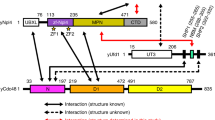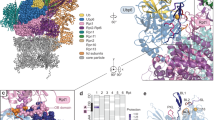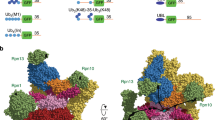Abstract
Polyubiquitin chains target protein substrates to the 26S proteasome, where they are removed by the deubiquitinase Rpn11 to allow efficient substrate degradation. Despite Rpn11's essential function during substrate processing, its detailed structural and biochemical characterization has been hindered by difficulties in purifying the isolated enzyme. Here we report the 2.0-Å crystal structures of Zn2+-free and Zn2+-bound Saccharomyces cerevisiae Rpn11 in an MPN-domain heterodimer with Rpn8. The Rpn11-Rpn8 interaction occurs via two distinct interfaces that may be conserved in related MPN-domain complexes. Our structural and mutational studies reveal that Rpn11 lacks a conserved surface to bind the ubiquitin Ile44 patch, does not interact with the moiety on the proximal side of the scissile isopeptide bond and exhibits no linkage specificity for ubiquitin cleavage. These findings explain how Rpn11 functions as a promiscuous deubiquitinase for cotranslocational substrate deubiquitination during proteasomal degradation.
This is a preview of subscription content, access via your institution
Access options
Subscribe to this journal
Receive 12 print issues and online access
$189.00 per year
only $15.75 per issue
Buy this article
- Purchase on Springer Link
- Instant access to full article PDF
Prices may be subject to local taxes which are calculated during checkout





Similar content being viewed by others
References
Finley, D. Recognition and processing of ubiquitin-protein conjugates by the proteasome. Annu. Rev. Biochem. 78, 477–513 (2009).
Glickman, M.H. & Ciechanover, A. The ubiquitin-proteasome proteolytic pathway: destruction for the sake of construction. Physiol. Rev. 82, 373–428 (2002).
Pickart, C.M. Mechanisms underlying ubiquitination. Annu. Rev. Biochem. 70, 503–533 (2001).
Xu, P. et al. Quantitative proteomics reveals the function of unconventional ubiquitin chains in proteasomal degradation. Cell 137, 133–145 (2009).
Saeki, Y. et al. Lysine 63-linked polyubiquitin chain may serve as a targeting signal for the 26S proteasome. EMBO J. 28, 359–371 (2009).
Thrower, J.S., Hoffman, L., Rechsteiner, M. & Pickart, C.M. Recognition of the polyubiquitin proteolytic signal. EMBO J. 19, 94–102 (2000).
Matyskiela, M.E. & Martin, A. Design principles of a universal protein degradation machine. J. Mol. Biol. 425, 199–213 (2013).
Saeki, Y. & Tanaka, K. Assembly and function of the proteasome. Methods Mol. Biol. 832, 315–337 (2012).
Groll, M. et al. Structure of 20S proteasome from yeast at 2.4 A resolution. Nature 386, 463–471 (1997).
Groll, M. et al. A gated channel into the proteasome core particle. Nat. Struct. Biol. 7, 1062–1067 (2000).
Glickman, M.H., Rubin, D.M., Fried, V.A. & Finley, D. The regulatory particle of the Saccharomyces cerevisiae proteasome. Mol. Cell. Biol. 18, 3149–3162 (1998).
Smith, D.M. et al. Docking of the proteasomal ATPases' carboxyl termini in the 20S proteasome's a ring opens the gate for substrate entry. Mol. Cell 27, 731–744 (2007).
Beckwith, R., Estrin, E., Worden, E.J. & Martin, A. Reconstitution of the 26S proteasome reveals functional asymmetries in its AAA+ unfoldase. Nat. Struct. Mol. Biol. 20, 1164–1172 (2013).
Erales, J., Hoyt, M.A., Troll, F. & Coffino, P. Functional asymmetries of proteasome translocase pore. J. Biol. Chem. 287, 18535–18543 (2012).
Zhang, F. et al. Mechanism of substrate unfolding and translocation by the regulatory particle of the proteasome from Methanocaldococcus jannaschii. Mol. Cell 34, 485–496 (2009).
Peth, A., Nathan, J.A. & Goldberg, A.L. The ATP costs and time required to degrade ubiquitinated proteins by the 26 S proteasome. J. Biol. Chem. 288, 29215–29222 (2013).
Verma, R. et al. Role of Rpn11 metalloprotease in deubiquitination and degradation by the 26S proteasome. Science 298, 611–615 (2002).
Yao, T. & Cohen, R.E. A cryptic protease couples deubiquitination and degradation by the proteasome. Nature 419, 403–407 (2002).
Inobe, T., Fishbain, S., Prakash, S. & Matouschek, A. Defining the geometry of the two-component proteasome degron. Nat. Chem. Biol. 7, 161–167 (2011).
Sato, Y. et al. Structural basis for specific cleavage of Lys 63-linked polyubiquitin chains. Nature 455, 358–362 (2008).
Beck, F. et al. Near-atomic resolution structural model of the yeast 26S proteasome. Proc. Natl. Acad. Sci. USA 109, 14870–14875 (2012).
Matyskiela, M.E., Lander, G.C. & Martin, A. Conformational switching of the 26S proteasome enables substrate degradation. Nat. Struct. Mol. Biol. 20, 781–788 (2013).
Lander, G.C. et al. Complete subunit architecture of the proteasome regulatory particle. Nature 482, 186–191 (2012).
Cooper, E.M. et al. K63-specific deubiquitination by two JAMM/MPN+ complexes: BRISC-associated Brcc36 and proteasomal Poh1. EMBO J. 28, 621–631 (2009).
Estrin, E., Lopez-Blanco, J.R., Chacon, P. & Martin, A. Formation of an intricate helical bundle dictates the assembly of the 26S proteasome lid. Structure 21, 1624–1635 (2013).
Echalier, A. et al. Insights into the regulation of the human COP9 signalosome catalytic subunit, CSN5/Jab1. Proc. Natl. Acad. Sci. USA 110, 1273–1278 (2013).
Sanches, M., Alves, B.S., Zanchin, N.I. & Guimaraes, B.G. The crystal structure of the human Mov34 MPN domain reveals a metal-free dimer. J. Mol. Biol. 370, 846–855 (2007).
Cooper, E.M., Boeke, J.D. & Cohen, R.E. Specificity of the BRISC deubiquitinating enzyme is not due to selective binding to Lys63-linked polyubiquitin. J. Biol. Chem. 285, 10344–10352 (2010).
Hofmann, K. & Bucher, P. The PCI domain: a common theme in three multiprotein complexes. Trends Biochem. Sci. 23, 204–205 (1998).
Wang, B. et al. Abraxas and RAP80 form a BRCA1 protein complex required for the DNA damage response. Science 316, 1194–1198 (2007).
Sobhian, B. et al. RAP80 targets BRCA1 to specific ubiquitin structures at DNA damage sites. Science 316, 1198–1202 (2007).
Davies, C.W., Paul, L.N., Kim, M.I. & Das, C. Structural and thermodynamic comparison of the catalytic domain of AMSH and AMSH-LP: nearly identical fold but different stability. J. Mol. Biol. 413, 416–429 (2011).
Ye, Y. et al. Ubiquitin chain conformation regulates recognition and activity of interacting proteins. Nature 492, 266–270 (2012).
Pickart, C.M. & Raasi, S. Controlled synthesis of polyubiquitin chains. Methods Enzymol. 399, 21–36 (2005).
Ciechanover, A., Elias, S., Heller, H. & Hershko, A. “Covalent affinity” purification of ubiquitin-activating enzyme. J. Biol. Chem. 257, 2537–2542 (1982).
Dong, K.C. et al. Preparation of distinct ubiquitin chain reagents of high purity and yield. Structure 19, 1053–1063 (2011).
Sem, D.S. & McNeeley, P.A. Application of fluorescence polarization to the steady-state enzyme kinetic analysis of calpain II. FEBS Lett. 443, 17–19 (1999).
Adams, P.D., Mustyakimov, M., Afonine, P.V. & Langan, P. Generalized X-ray and neutron crystallographic analysis: more accurate and complete structures for biological macromolecules. Acta Crystallogr. D Biol. Crystallogr. 65, 567–573 (2009).
Emsley, P. & Cowtan, K. Coot: model-building tools for molecular graphics. Acta Crystallogr. D Biol. Crystallogr. 60, 2126–2132 (2004).
Acknowledgements
We thank the members of the Martin laboratory for helpful discussions and D. Morgan (University of California, San Francisco) for providing expression constructs for E1 and E2 enzymes. We are also grateful to M. Herzik (University of California, Berkeley) and A. Lyubimov (Stanford University) for help with crystallography data collection and processing. E.J.W. acknowledges support from the US National Science Foundation Graduate Research Fellowship. This research was funded in part by the Searle Scholars Program (A.M.), start-up funds from the University of California, Berkeley Department of Molecular and Cell Biology (A.M.) and the US National Science Foundation CAREER Program (NSF-MCB-1150288 to A.M.).
Author information
Authors and Affiliations
Contributions
E.J.W. and A.M. designed experiments; E.J.W. and C.P. expressed, purified and characterized protein variants; and E.J.W. performed X-ray crystallographic studies. E.J.W. and A.M. prepared the manuscript.
Corresponding author
Ethics declarations
Competing interests
The authors declare no competing financial interests.
Integrated supplementary information
Supplementary Figure 1 Electron density of the Rpn11 catalytic active site in the apo and Zn2+-bound states.
(a) The 2|Fo|-|Fc| electron density map of the Zn2+-bound active site is shown in grey and contoured at 1.5σ. Depicted in cyan is the |Fo|-|Fc| difference electron density map contoured at 5σ, calculated from the final coordinates after three rounds of ADP and reciprocal space XYZ refinement with the Zn2+ ion and the catalytic water omitted. (b) 2|Fo|-|Fc| electron density map of the Rpn11 active site in the apo state, contoured at 1.5σ. Also included is the corresponding |Fo|-|Fc| difference electron density map contoured at 5σ, which does not show any peaks at this contouring level.
Supplementary Figure 2 Specific interface residues facilitate Rpn11–Rpn8 heterodimer formation.
Close-up view of interactions between Rpn11 (green) and Rpn8 (blue, surface representation) at interface 2. Rpn8 Gly170 packs against Rpn11 Leu34, Leu35, and Leu38 (shown in stick representation). For the interaction of the corresponding residue Rpn11 Met212 with Rpn8 see Figure 1e.
Supplementary Figure 3 Alignment of the hydrophobic dimerization interfaces of Rpn11 and related MPN-containing proteins.
Residues of the hydrophobic interfaces 1 and 2 predicted to contribute >0.45 kcal/mol of binding energy between Rpn11 and Rpn8 are colored red. Residues predicted to be at the same position in other proteins are colored red if hydrophobic.
Supplementary Figure 4 Alignment of the hydrophobic dimerization interfaces of Rpn8 and related MPN-containing proteins.
Residues of the hydrophobic interfaces 1 and 2 predicted to contribute >0.45 kcal/mol of binding energy between Rpn11 and Rpn8 are colored red. Residues predicted to be at the same position in other proteins are colored red if hydrophobic.
Supplementary Figure 6 Example gels for the Lys48-linked diubiquitin cleavage assay of Rpn11.
Shown are the gels for one Michealis-Menten experiment analyzing the 30-minute time courses of Lys48-linked di-ubiquitin cleavage by wild-type Rpn11-Rpn8 (5 μM) at substrate concentrations between 15 and 500 μM. Bands indicated by asterisks are due to contaminating proteins that co-purify at low abundance with Rpn11 and Rpn8 heterodimers. Covalently linked ClpX hexamer was used for normalization of staining and enzyme concentrations across different gels, which were all processed in parallel.
Supplementary Figure 7 The N terminus and Ins-2 region of Rpn11 contact Rpn2.
Crystal structures of the Rpn11-Rpn8 dimer and Rpn2 (ref. 1) (PDB ID: 4ADY), with Rpn11 in green, Rpn8 in blue and Rpn2 in orange, are docked into the segmented EM 3D-reconstruction of the substrate-bound 26S proteasome2 (EMDB ID: EMD-5669). The Ins-1 loop of Rpn11 is colored gold. The N-terminal residue of Rpn11 as well as the residues flanking its unstructured Ins-2 region are colored red and labeled. Extra electron density not accounted for by the crystal structures of Rpn11-Rpn8 and Rpn2, and presumably corresponding to the Ins-2 region of Rpn11, is circled.
Supplementary Figure 8 Fluorescence-based assays for Rpn11 ubiquitin binding and cleavage.
(a) Example time-based polarization measurements of the cleavage of 5 and 10 μM Ub-Lys-TAMRA by 1.25 μM Rpn11-Rpn8. (b) Example single-turnover kinetics measurement for the cleavage of 100 nM Ub-Lys-TAMRA by 450 μM Rpn11-Rpn8. The data are fit by a single exponential, with a calculated kcat = 0.95 min−1. (c) Michaelis-Menten curve for Ub-Lys-TAMRA cleavage by Rpn11, where kcat was constrained to the experimentally determined value in (b). Limitations in substrate solubility precluded using Ub-Lys-TAMRA at concentrations higher than KM, so measurement of a complete curve was not possible. The estimated KM for Ub-Lys-TAMRA cleavage by Rpn11 is 20 μM. (d) Tryptophan fluorescence-based assay of K48-linked di-ubiquitin binding to Rpn11V80A. Tryptophan fluorescence of 5 μM Rpn11-Rpn8 heterodimers was measured in the presence of Lys48-linked di-ubiquitin at concentrations between 0 and 500 μM, as discussed in the methods. Triplicate fluorescence measurements were averaged and fit to a simple binding curve with a KD of 67 μM.
Supplementary information
Supplementary Figures
Supplementary Figures 1–8 (PDF 12936 kb)
Rights and permissions
About this article
Cite this article
Worden, E., Padovani, C. & Martin, A. Structure of the Rpn11–Rpn8 dimer reveals mechanisms of substrate deubiquitination during proteasomal degradation. Nat Struct Mol Biol 21, 220–227 (2014). https://doi.org/10.1038/nsmb.2771
Received:
Accepted:
Published:
Issue Date:
DOI: https://doi.org/10.1038/nsmb.2771
This article is cited by
-
Neutron-encoded diubiquitins to profile linkage selectivity of deubiquitinating enzymes
Nature Communications (2023)
-
POH1/Rpn11/PSMD14: a journey from basic research in fission yeast to a prognostic marker and a druggable target in cancer cells
British Journal of Cancer (2022)
-
Deubiquitylases in developmental ubiquitin signaling and congenital diseases
Cell Death & Differentiation (2021)
-
Backbone 1H, 13C and 15N resonance assignments of the proteasome lid subunit Rpn12 from Saccharomyces cerevisiae
Biomolecular NMR Assignments (2020)
-
Inactivity of YGL082W in vitro due to impairment of conformational change in the catalytic center loop
Science China Chemistry (2020)



